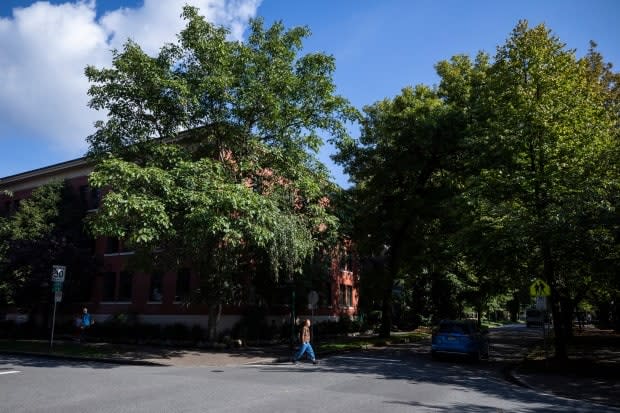Metro Vancouver creates tool kit for cities to retain, grow tree canopies

Metro Vancouver has developed a guide for its federation of 21 municipalities to manage urban forests, which are proven to make cities more livable, healthy and cooler.
The Metro Vancouver Tree Regulations Tool Kit includes "must haves" for city officials to use to balance development and the need for tree canopy cover.
Tree canopy is the amount of ground covered by leaves and branches in cities as seen from above.
"They can help buffer the impacts of climate change, which is extreme heat, and storm water management," said Edward Nichol, a regional planner with Metro Vancouver who worked on the plan.
"I think we are really starting to see trees and other forms of green infrastructure being viewed as essential forms of city infrastructure."
Trees versus development
For decades, canopy covers have been in decline in cities like Vancouver, but planners are trying to change that.
In September, the City of Vancouver met a 10-year tree planting goal to try to raise its tree canopy to 22 per cent from 18 per cent.
Metro Vancouver has a goal of increasing tree canopy across the region to a net value of 40 per cent by 2050 from 32 per cent.
The goal is tempered by a Metro Vancouver study from September 2019 that showed development, such as housing and roads, would result in a decline in canopy cover over the next three decades.
"This is a region where there is a lot of competition for land and a lot of the growth that we're seeing is in the urban areas of the region so competition for spaces is certainly a factor here," said Nichol.
The tool kit is meant to address the competition between finding space and growing areas for trees in cities, which are becoming increasingly dense with housing.

The tool kit includes 12 "must have" policies or bylaws, which range from tree protection bylaws that penalize people who remove trees of certain sizes without permits to what trees that are legally removed should be replaced with.
Nichol said the tool kit is not meant to be prescriptive, but to give municipalities options for achieving tree canopy goals.
No 'silver bullet'
"It would be nice in a perfect world if there was a silver bullet solution but in many cases there are so many other factors to keep in mind that we wanted to keep it flexible," Nichol said.
UBC forestry professor Stephen Sheppard says the guide is desperately needed. Metro Vancouver says about a quarter of municipalities in the federation have not yet adopted tree protection bylaws.
"This is such an important issue," said Sheppard. "The current heat wave is the classic reminder that climate change is going to be very real and quite damaging and we're going to need all the trees we can get to cool us down and provide many other important benefits for our communities."

Sheppard would have liked to see more minimum requirements in the guide, such as setting a minimum size for trees that would require a permit to be removed.
Vancouver recently moved to change its rules around trees that require an assessment and a permit to be removed.
Previously a tree measuring 20 cm in diameter at breast height required a permit to be removed. The threshold is now 30 cm in diameter for at least the next 12-months.
The move was made to streamline what can often be a slow and expensive permit process. Sheppard said the change comes with a different cost.
"Making it easier to remove medium, maturing trees without a permit is kind of going in the opposite direction of the city's own canopy and green infrastructure targets," he said.
He hopes individual homeowners will make it a priority to plant trees on their properties and maintain them over time so they can help bolster tree canopies in their neighbourhoods.

